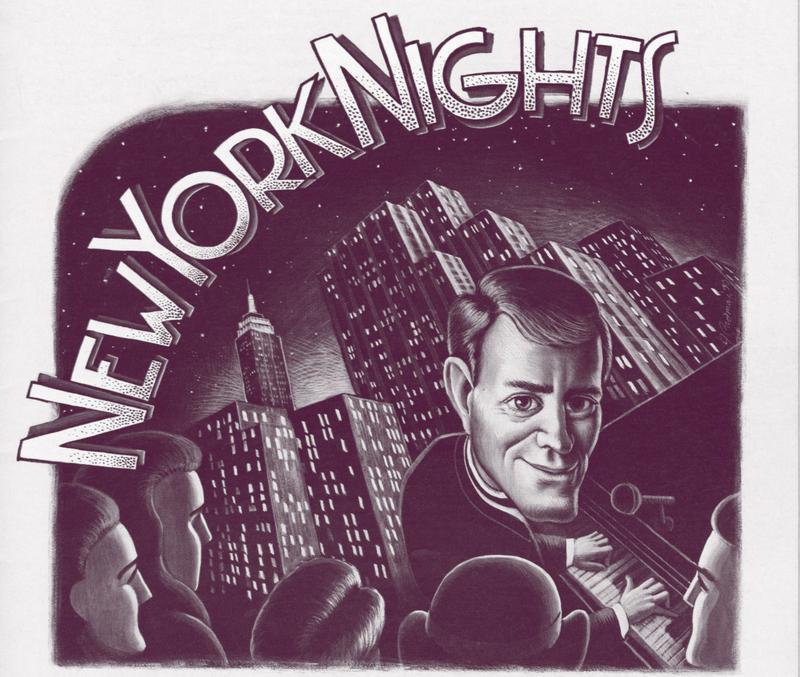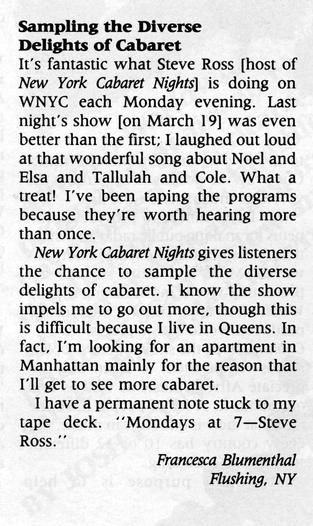 NYPR Archives & Preservation
NYPR Archives & Preservation
New York Cabaret Nights : A Reintroduction

“New York Days become New York Nights when the sun goes down…”*
So goes the theme song for “New York Cabaret Nights” a weekly series of 26 live performances broadcast in 1990 from three historic cabaret venues – Rainbow and Stars, the small jewel box theatre adjacent to the famous Rainbow Room; the Algonquin Hotel’s legendary Oak Room; and The Ballroom, the Spanish restaurant and theatre located in historic Chelsea. Showcasing performances from venerable as well as up and coming cabaret performers, the programs brought to radio audiences the glamour and intimacy of the cabaret experience that previously was the province of only those who could attend a show at one of the sophisticated night spots that once dotted Manhattan.
Allison Chernow, WNYC’s Executive Producer of Live Broadcasts at the time, recalls feeling “the elegance of broadcasting from Rainbow and Stars and from the Algonquin … These felt like such classic, New York-y venues —and the intimacy and warmth of the clubs and the cabaret performers’ patter translated well to live radio.” The host for the shows, Steve Ross (a well-known and seasoned cabaret performer himself), had no prior radio experience but was a natural. “I had to watch very carefully the clock,” recalls Ross. “And I had to time the numbers: 3 minutes for the song, 2 minutes for the talk.” Despite these constraints, Ross found the experience “wonderful.” Recalling the gala premiere broadcast, Ross remembers, “Maureen McGovern, already a star (and I was a bit in awe of her that first night) came over and pressed my arm and said, ‘Don’t worry about anything, I’m a big fan of yours.' I wasn’t panicky, but it was very sweet that everybody jumped in and went along with the program. They weren’t divas, they realized maybe subconsciously it would be a legacy of some kind.”
In addition to established cabaret performers such as Michael Feinstein, Karen Akers, Andrea Marcovicci, Julie Wilson, and Margaret Whiting, the shows featured newer artists such as KT Sullivan and the group Betty, and composers such as Sheldon Harnick (Fiddler on the Roof, She Loves Me), Marty Charnin (Annie), and Bart Howard (Fly Me to the Moon). Ross remembers, “there was not a dud of any who performed!”
The show proved popular among listeners. “The series was broadcast during the pre-internet years, when there weren’t easy opportunities for listener feedback,” says Chernow. “But I do remember getting more positive letters about this show than most others. It tapped into a lot of our listeners’ sense of nostalgia and humor, especially the Cole Porter songs.”
Ross notes, “Once, a couple of times a year people come up to me and say, 'Gee, what ever happened to those wonderful programs?' They were wonderful for people who either couldn’t or chose not to go out at night.” The 26 shows were eventually edited into 13 shorter programs that were distributed nationally by American Public Media, providing what Chernow characterizes as a “uniquely Manhattan” experience to a wider audience.
Almost thirty years after the live broadcasts, none of the venues exists as a cabaret. The building that housed the Ballroom became a New York University fraternity; Rainbow and Stars closed in 1998; and the Oak Room in the Algonquin closed in 2012 and is now a private breakfast room for Marriot Reward Elite customers.
However, listeners can revisit these venues in their earlier, glamorous incarnation and experience cabaret’s elegance and intimacy once again with these digitized recordings of most of the original broadcast tapes that previously were scattered in various locations but now are available to enjoy on our website.
*Song written by Richard Jenkins.
